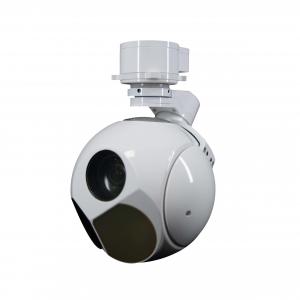Product Details
Three Axis IR EO Sensor UAV Gimbal Camera with Laser Ranging Function
TS130CT-02 has three lights includes visible light, IR and Laser,
which makes it achieved a wider working range. TS130CT-02 is a
gimbal camera for long range surveillance and inspection. It
integrates a 30x optical zoom SONY 1/1.8” Type circadian camera and
a 35mm 12μm IR thermal camera and 3000m laser rangefinder. Support
stable target tracking and recognization. With 3-axis
high-precision, the camera have advantages fot its' better aluminum
alloy housing, anti-interference and heat dissipation. It is widely
used in UAV industries of long range mission like inspection,
surveillance, rescue and other challenging applications.e and other
industrial applications.
Functions
1. Provide the infrared video and image for detection area
2. High precision and stabilization of visual axis
3. Capability of detection and recognition for ground target
4. Support searching, tracking, locking, guiding, etc working modes
5. Support characters overlay, custom and display
6. support target postioning and laser ranging
7. Self-inspection and fault diagnosis
8. UDP control and video (UDP/RTSP) transmission by Ethernet
9. IR Pseudo-color temperature measurement
10. Built in video and image storage
Specifications
| EO sensor | Wavelength | 0.4μm~0.9μm |
| Resolution | 1920x1080 |
| Focal length | 4.3mm~129mm(30X) |
| FOV | 63.7°~2.3° |
| Video output | HD-SDI(1080P 30Hz) |
| Distance | PEOPLE:Detection 6km;Recognition 2km VEHICLE:Detection
15km;Recognition 8km |
| IR sensor | IR Type | LWIR(un-cooled) |
| Wavelength | 8~14μm |
| Resolution | 640x512 |
| Pixel | 12um |
| NETD | 50mk |
| Focus length | 35mm/F1.0 |
| FOV | 12.5º×10º |
| Distance | PEOPLE:Detection 0.7km; Recognition 0.22km
VEHICLE:Detection 4.2km; Recognition 1km |
| Laser rangefinder | Wavelength | 905nm/1535nm |
| Performance | |
| Ranging distance | 1.5km(3km optional) |
| Ranging accuracy | ±3 |
| Servo System | Rotating limits | 360º continuous Pan, Pitch: -110° ~+10 º |
| Angular accuracy: | ≤2mrad |
| Stablization accuracy | ≤100μrad(1σ)(2°/Hz,1°/Hz Swing) |
| Max.angular speed | ≥50°/s |
| Max. angular acceleration: | ≥90°/S |
| Tracking Functions | Motion speed: | 30pixel/frame |
| Target imaging contrast: | 8% |
| Target imaging pixel(Mini) | 4x3 pixels |
| Support | Anti -occlusion without loss of function |
| Interface | Communication
interface | RS422 x1(TTL optional) |
| Video output | Ethernet |
Picture
Mechanical Drawing
Working Principle of Optical Platform Tracking System
The tracking system first searches for the target in the
more-viewed-but-less-viewed mode, and then switches to the
less-viewed-but-more-viewed mode when it finds traces of the
target.Tracking refers to the process of localising a moving target
over time. When a tracking system uses an optoelectronic sensor
(e.g., a charge-coupled device (CCD: Charge-Coupled Device)) to
acquire a sequence of pictures of the target's motion, we refer to
it as an optoelectronic tracking system. Photoelectric tracking
systems commonly use composite-axis tracking technology, which
involves two drive units, the rack and the precision tracking
stage. Firstly, the rack should derive the positioning rotation
signal according to the guidance signal, and make the target appear
on the coarse detector with a large field of view and low sampling
frequency by its own rotation, and get the positioning result with
a large travelling range and low tracking accuracy driven by the
torque of the control loop. On the basis of decreasing tracking
error of the coarse detector, the remaining residual of target
tracking generated by the rack servo system enters the secondary
tracking. The precision tracking platform drives the motor by the
off-target amount obtained from the fine detector with small field
of view and high sampling frequency, and the final accuracy of the
optic axis pointing is obtained under the tracking performance with
small travel range and high tracking accuracy. The ultimate task of
the optical tracking system is to continuously reduce the apparent
axis error between the device and the target by driving the
instrument through the motor.
Certificate of HONPHO
Company Profile
Chengdu HONPHO Technology Co., Ltd. was established in March 2018. It is a national high-tech
enterprise focusing on R&D, intelligent manufacturing and
service of high-end photoelectric system. HONPHO main product is
spherical photoelectric payload systems, this payload wildly
deployed in UAV,unmanned ships, umanned vehicle,helicopter and low
speed fixed wing aricrafy. especially for reconnaissance and strike
UAV and armed helicopter. HONPHO has nearly 5,000 square meters of
space to meet the needs of R&D, production, operation and
office. More than 100 employees, include 2 national senior experts,
3 doctors, 21 masters, 10 technical experts with senior titles and
4researchers are joined HONPHO. HONPHO won more than 10 prizes of
national and national defense science and technology progress , and
have over 20 intellectual property rights. We are committed to
building HONPHO into a world-renowned photoelectric system
high-tech enterprise.






